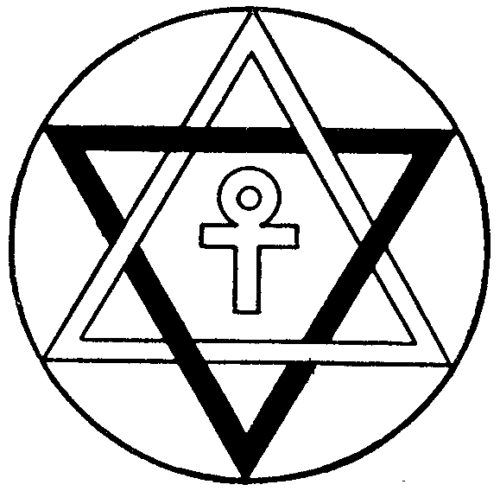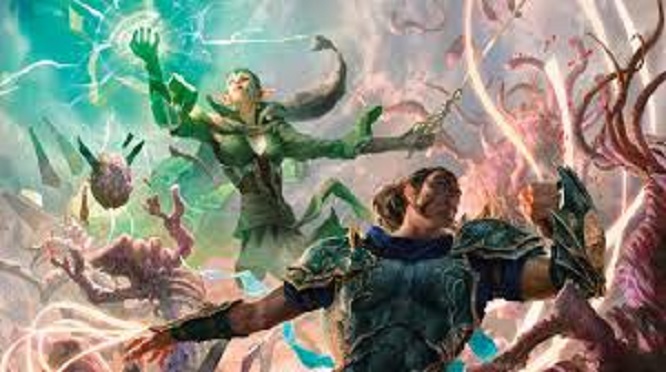The magical and mystical references and themes of Magic: the Gathering are a rich part of the background of the story world, and many play it for that reason. The reality is that Magic is not just occult in flavour and appearance but also in fundamental structure and gameplay. As this essay will describe, the layout of the five fundamental Magic colours maps out a space in occult philosophy.
Many people are familiar with the conception of four classical elements of earth, water, air and fire. These are said to represent various elemental forces, viz. being cold and dry in the case of earth, cold and wet in the case of water, warm and wet in the case of air and warm and dry in the case of fire. More precisely, these are what are known as the four feminine elements, because they all have equal value.
Being four elements of equal value, they can be distinguished on the basis of yin and yang. The yin elements are Earth and Water, because they are cold and passive. The yang elements are Air and Fire, because they are warm and active. Earth relates to inertia, Water relates to cohesion, Air to expansion and Fire to heat.
There are also such things as the four masculine elements, which all have differing value. These four elements collapse into a basic dichotomy between precious things that need to be guarded or defended and base things that do not. These precious things are usually characterised as white on account of the light nature of silver and gold, whereas base things are usually characterised as black on account of the dark nature of clay and iron.
This masculine dichotomy and feminine quadrichotomy combine to give us a system based around six separate points – a system that the reader may have previously seen diagrammed (as below) in various occult symbols and drawings.

In this model, Air and Fire are the bottom corners of the white triangle, because they are warm and therefore rise upwards. Earth and Water are the top corners of the black triangle, because they are cold and therefore sink downwards. The uppermost point of the white triangle represents spirituality, which seeks to rise above matter, and the bottommost point of the black triangle represents materialism, which indulges in it.
The masculine axis is represented by the vertical line of the central ankh, and the feminine axis by the horizontal line. So in this diagram all of creation is represented: all of the physical, the metaphysical, the feminine, the masculine, the spiritual and the material worlds can be found therein.
Where it gets interesting is how this esoteric diagram maps to the five different colour types in M:tG.
Blue represents both Air Magic and Water Magic. In this it combines the intellectualism of Air with the flexibility of Water to create a magic that tricks, deceives, binds and maddens. It’s also a magic that can open up new intellectual possibilities and mental realms. Air and Water are the two wet elements, and so it’s fitting that blue is a slippery and ephemeral colour.
Red represents Fire Magic. This is encapsulated not only in the obvious fire, lightning and volcano-related imagery but also in red magic’s use of chaos. Fire is the most chaotic form of matter, because solids, liquids and even gasses all behave in reasonably predictable ways. This is why red uses cards like ‘Wheel of Fortune’.
Green represents Earth Magic. This refers to the natural world and to the procreative qualities of the natural world. The classic Green Magic strategy is to overrun one’s opponent, to crush them by sheer mindless mass or weight of numbers. Trample is the quintessential ability of Green Magic, as are magics that represent damage done by natural phenomena such as hurricanes and poisons.
White represents spirituality, or White Magic. To this end, most of the healing magic is white in nature (in this sense, M:tG lifts many of their concepts from existing esoteric philosophy). The point of White Magic is to banish the darkness or suffering, hence their use of wards and salves. White also plays on the idea of God acting upon the world through cards such as ‘Wrath of God’ and ‘Armageddon’.
Black represents materialism, or Black Magic. Perhaps the characteristic card of this colour is ‘Greed’. Elegant practitioners of Black Magic will use other people’s materialistic desires to exploit them, or to manipulate them into furthering the magician’s wishes. Life imitates art in the sense that Black Magic is essentially the same in M:tG as in real life.
So the five colours of a Magic game represent five alchemical positions on two fundamental axes: masculine on the masculine axis (white), feminine on the masculine axis (black), masculine on the feminine axis (red), feminine on the feminine axis (green) and neutral on the feminine axis (blue).
A game of Magic can be thought of as an alchemical battle, with the player who is greatest able to project power through their mastery of the elements the winner. Curiously, there is no guarantee that the forces of “good” will win any given battle, which is what gives the game its dramatic potential. The side with the angels and God on it can still be defeated by competent Black Magic or by any other alliance.
*
If you enjoyed reading this essay, you can get a compilation of the Best VJMP Essays and Articles of 2018 from Amazon for Kindle or Amazon for CreateSpace (for international readers), or TradeMe (for Kiwis). A compilation of the Best VJMP Essays and Articles of 2017 is also available.

